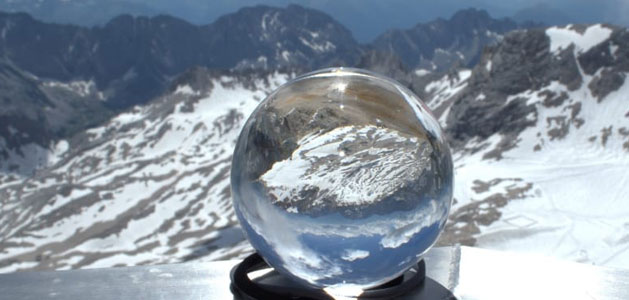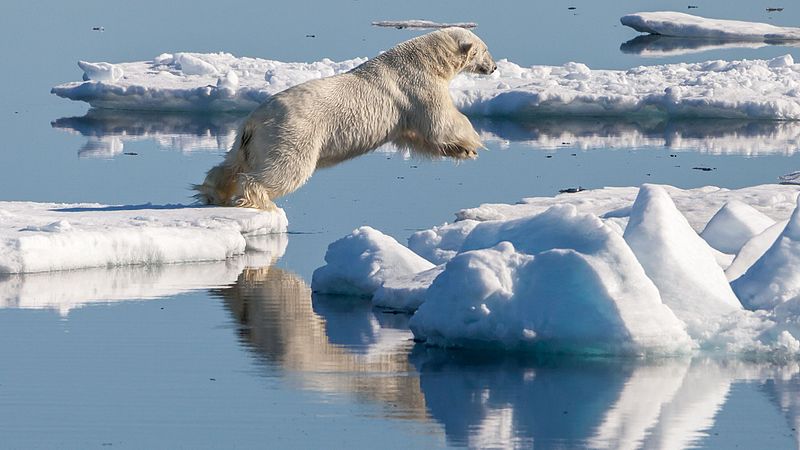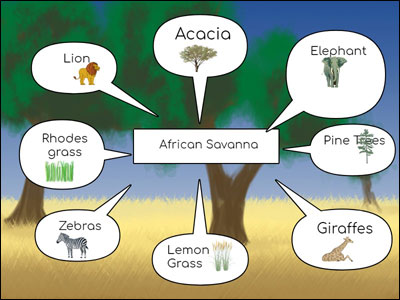
Apps: Wixie®

Snow globes are popular souvenirs from tourist attractions. In this project, students research the animals and plants in a specific habitat and design a habitat snow globe.
Since students love animals, using a specific animal to introduce your students to the concept of a habitat.
For example, you can show your students a picture of a polar bear, such as this amazing image from Andreas Weith on Wikipedia.

As a class, conduct a brainstorming session to tap into knowledge your students may already have about what polar bears need to survive. What weather and climate would it need? What does it eat? What plants and animals provide food for a polar bear’s diet?
Read the book Where do Polar Bears Live? by Sarah L. Thompson to introduce your students to facts about polar bear’s habitats and to discover if their predictions were accurate.
Use a mix of print, image, and video resources to introduce your students to the idea of habitats. Watch this video on habitats.
Let students know that they will be designing a snow globe to represent a specific habitat, showing important plants and animals that live in it.
Collect different examples of snow globes or ask students (parents) to bring their own snow globes to class. Once you have several sample snow globes, ask students to identify and think about the objects in each one. For example, a snow globe for a tourist destination may include important buildings and monuments to to show you what you might see if you visited that location.
First, ask students to observe the objects in each snow globe. Then, ask them to think about why the snow globe designer chose those objects. Discuss what the purpose of each snow globe might be.
Have individual students choose a habitat they are interested in learning more about. Do your best to Get students excited about all of the different habitats and biomes so you have a well-rounded classroom introduction to various habitats. You may want to have students list their top three choices so you can ensure they at least get a habitat that interests them and you ensure a range to explore and compare.
Ask students to conduct research about the identifying features of the habitat they are interested in, such as weather and climate, as well as some of the key plant and animal species that live there.
Have students take notes and represent information they find using a cluster organizer.

Create a Graphic Organizer
Need a thought web, timeline, flowchart, or other graphic organizer for a lesson?
CreateProvide students with an empty snow globe template and have students draw a design showing the plants and animals found there.
If your students have access to a digital creativity tool like Wixie®, you can assign a snow globe template to them. Students can use Wixie’s paint tools to draw their designs, as well as add images from the media library.
Wixie’s media library has an opaque snowglobe students can layer on top of their snowglobe designs when they are finished. To find this sticker, select the Image button and search for “snow globe” at the dialog.
Students should write and add a paragraph about their design, describing the habitat and why they chose specific animals and plants to represent the habitat.
Create an area for a snow globe showcase in one part of your room. Task students with designing the display so that designs for the same habitat are grouped together.
Ask students with snow globes for the same habitat to compare their work and identify similarities and differences in their designs. Then, ask each student to complete a self-reflection about their work. Their self-reflection should include the strengths of their design, as well as ways they feel they might be able to improve upon their designs after viewing and discussing their classmate’ designs.
Invite students in other classes to tour the showcase to learn about different habitats. Your designers can act as docents to describe their work and answer questions. You might also want to invite a local landscape designer or zoologist to visit or even evaluate student designs.
Initial discussions about habitats with your students will help you assess their prior knowledge about different habitats, as well as the plants and animals found in them. Their snow globe design serves as a summative assessment helping you evaluate student understanding of plant and animal adaptations that help them survive.
You can also evaluate student thinking as they discuss the similarities and differences between snow globe designs for the same habitat. Student self-reflections can also address how well a student understands the interplay between animals and plants in their habitat.
Donald Silver. One Small Square (series).
Sarah L. Thompson. Where do Polar Bears Live?. ISBN: 0061575186
Smithsonian Science Education Center: Habitats
3-LS4-1 Biological Evolution: Unity and Diversity
Make observations of plants and animals to compare the diversity of life in different habitats.
3-LS4-3 Biological Evolution: Unity and Diversity
Construct an argument with evidence that in a particular habitat some organisms can survive well, some survive less well, and some cannot survive at all.
4-LS1-1 From Molecules to Organisms: Structures and Processes
Construct an argument that plants and animals have internal and external structures that function to support survival, growth, behavior, and reproduction.
Reading Informational Text
CCSS.ELA-LITERACY.CCRA.RI.2.7
Explain how specific images (eg., a diagram showing how a machine works) contribute to and clarify a text.
CCSS.ELA-LITERACY.W.2.2
Write informative/explanatory texts in which they introduce a topic, use facts and definitions to develop points, and provide a concluding statement or section.
CCSS.ELA-LITERACY.W.2.7
Participate in shared research and writing projects (e.g., read a number of books on a single topic to produce a report; record science observations).
CCSS.ELA-LITERACY.CCRA.RI.3.7
Use information gained from illustrations (e.g., maps, photographs) and the words in a text to demonstrate understanding of the text (e.g., where, when, why, and how key events occur).
CCSS.ELA-LITERACY.W.3.2.A
Introduce a topic and group related information together; include illustrations when useful to aiding comprehension.
3. Knowledge Constructor
Students critically curate a variety of resources using digital tools to construct knowledge, produce creative artifacts and make meaningful learning experiences for themselves and others. Students:
a. plan and employ effective research strategies to locate information and other resources for their intellectual or creative pursuits.
b. evaluate the accuracy, perspective, credibility and relevance of information, media, data or other resources.
c. curate information from digital resources using a variety of tools and methods to create collections of artifacts that demonstrate meaningful connections or conclusions.
d. build knowledge by actively exploring real-world issues and problems, developing ideas and theories and pursuing answers and solutions.
6. Creative Communicator
Students communicate clearly and express themselves creatively for a variety of purposes using the platforms, tools, styles, formats and digital media appropriate to their goals. Students:
a. choose the appropriate platforms and tools for meeting the desired objectives of their creation or communication.
b. create original works or responsibly repurpose or remix digital resources into new creations.
c. communicate complex ideas clearly and effectively by creating or using a variety of digital objects such as visualizations, models or simulations.
d. publish or present content that customizes the message and medium for their intended audiences.

Follow us on Instagram for daily inspiration

Create a thought web, cluster, flowchart, or other graphic organizer for a lesson
8 first projects to get students using technology
Creative, digital book reviews
Fun and powerful ideas with animated characters

Wixie
Share your ideas, imagination, and understanding through writing, art, voice, and video.

Rubric Maker
Create custom rubrics for your classroom.

Pics4Learning
A curated, copyright-friendly image library that is safe and free for education.

Wriddle
Write, record, and illustrate a sentence.

Get creative classroom ideas delivered straight to your inbox once a month.
Topics